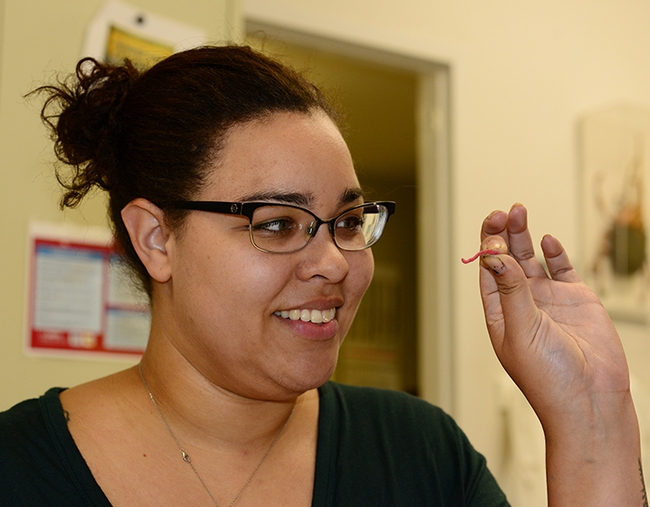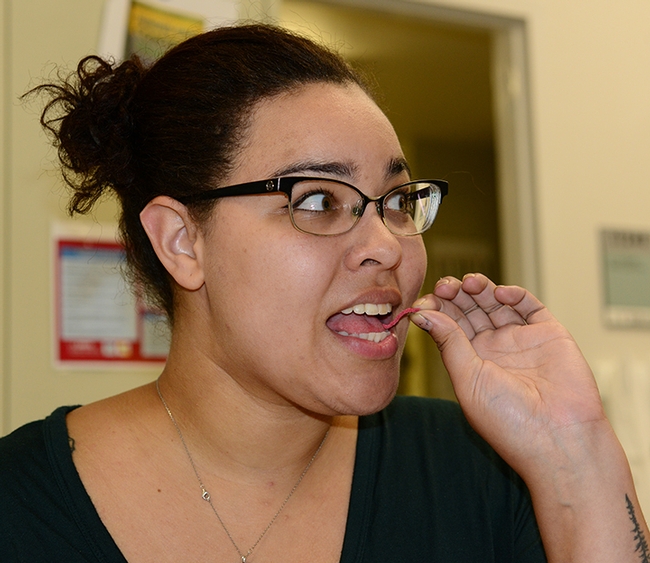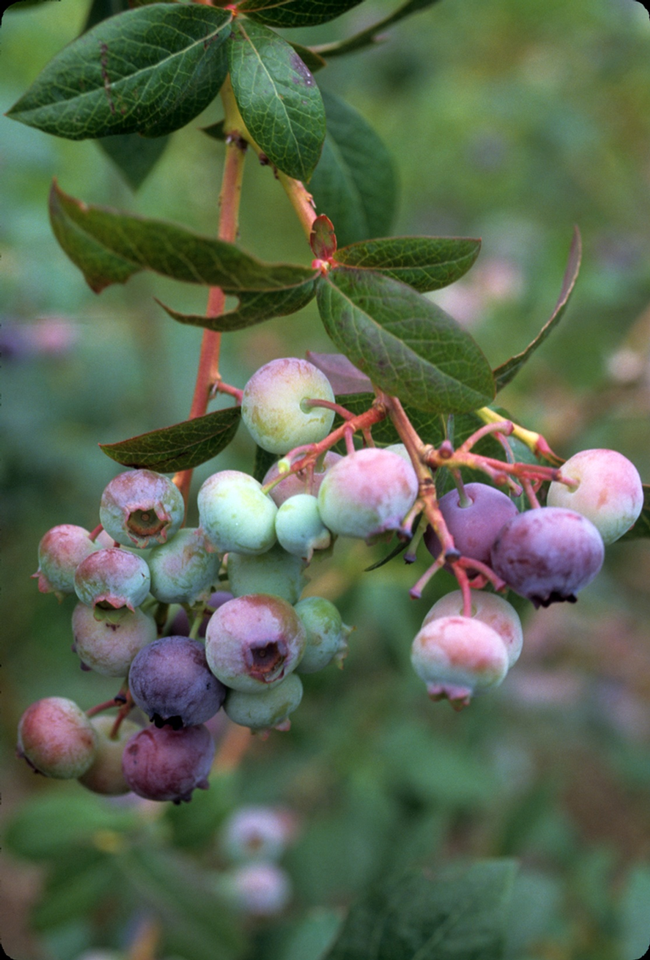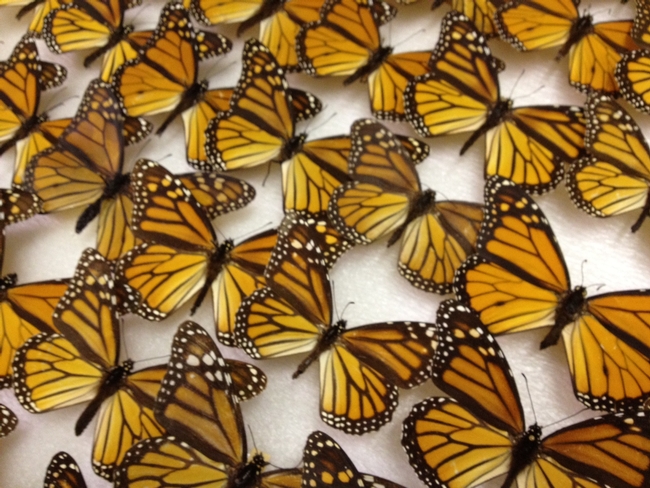
Posts Tagged: edible
This Bug's for You! Enjoy Tasty Bugs at the Bohart Museum Open House
Ever eaten a bug? Sure you have. Insect fragments are in just about all the foods we eat, from...

Biologist Iris Bright checks out a red earthworm, one of the items available for sampling at the Bohart Museum of Entomology's open house on Sept. 21. (Photo by Kathy Keatley Garvey)

The taste test! Biologist Iris Bright samples the red earthworm (and then other colors). "They're good," she said. (Photo by Kathy Keatley Garvey)
Was That Weed?
Occasionally plants show up in our office for identification and no one in the office knows what it...
Edible Education course draws a crowd

Not just what we eat, but also how food is produced and its impacts on the economy, health and the environment. How the food system has been transformed, why it matters and what we can do about it.
“People care about food,” said opening lecturer Michael Pollan, author and UC Berkeley journalism professor. “I think food is a very powerful teaching tool.”
Pollan and Chez Panisse chef Alice Waters, a UC Berkeley alumna who founded the Edible Schoolyard Project, started Edible Education in 2011 as a way to bring food education to undergraduate students. This semester's course — which is co-hosted by New York Times food columnist Mark Bittman and poet Robert Hass — has an added dimension: Lectures are being live streamed to the public. The opening lecture has received more than 7,000 views so far. Upcoming guest speakers will include Marion Nestle, Eric Schlosser and Raj Patel.
“We're a public university,” said course instructor Garrison Sposito, a renowned UC Berkeley soil scientist. “Let's reach the public. How can we do that in today's world? Let's do that by technology.”
As part of the UC Global Food Initiative, UC Berkeley also hopes to offer Edible Education as an online course available for credit to students throughout the UC system, said David Chai, special adviser to UC Berkeley Chancellor Nicholas Dirks.
Edible Education is presented by the Edible Schoolyard Project, Berkeley Food Institute, UC Berkeley College of Natural Resources and UC Global Food Initiative with support from the UC Berkeley Chancellor's Office and the Epstein/Roth Foundation.
Advancing food studies
“If you look at the lineup of speakers, it's pretty impressive,” said Bittman, who is a distinguished visiting fellow this spring at the Berkeley Food Institute. “I think the results will be fantastic.”
Having the support of UC President Janet Napolitano and the Global Food Initiative adds credibility to the study of food, said Nestle, a food studies, nutrition and public health expert who will deliver the next Edible Education lecture at 6:30 p.m. Feb. 2.
Nestle, a New York University professor with a visiting appointment at UC Berkeley's journalism school, recalled having to convince NYU's administration in 1996 that food studies was a suitable academic pursuit. “We were it at the time,” Nestle said. “Now everybody's doing it. It's very exciting.”
Hass, a UC Berkeley professor of English and former U.S. poet laureate who has taught an environmental studies course with Sposito, said that when they invited Pollan to speak nearly two decades ago, “you could see the way students were engaged. Immediately, they could connect.” Today's students are even more sophisticated, Hass said.
Increasing awareness
“It's important that we all become more aware of what the food industry is doing — I can't walk by without someone eating a hamburger,” UC Berkeley sophomore Audrey Nguyen said. “We can't sacrifice our health for convenience.”
Pollan said there is a place for meat but he encouraged people to eat less of it and said he would like to see changes in how animals are raised. During his lecture, “A Brief History of the Modern Food System,” he noted a rapid transformation into an oil-dependent food chain. He demonstrated his point by placing a McDonald's hamburger on a table with four glasses, into which he poured a dark liquid (chocolate syrup) meant to represent oil.
“(It takes) 26 ounces of oil to produce one double quarter pounder with cheese,” Pollan said. “We're eating a lot of oil.”
Upcoming Edible Education lectures will further explore the rise and future of the food movement.
Related links:
- Edible Education (includes link to watch lectures live)
- Food luminaries to light up spring semester
- Mark Bittman's menu to include UC Berkeley
- Food education streams into the spotlight
- UC Global Food Initiative
How to design your landscape and eat it, too
Edible landscapes are growing like zucchini in the sun as more people recognize the health and economic benefits of designing their yards with pretty plants that taste good, too.
“Sales of fruits and vegetables have remained strong, even during this recession when sales of other plants have lagged,” said Ron Hoffman, owner of Morris Nursery in Riverbank,Calif., echoing the sentiments of many in the state’s nursery industry. “People enjoy growing their own produce and they want plants that do double duty.”
And when they choose brightly colored edibles — like, say, Neon Lights swiss chard or Bronze lettuce — they can have their landscape and eat it, too. But designing and maintaining an edible landscape is easier said than done. How do you know what plants to choose? What if one plant needs different soil and more water than its neighbor? How do you keep the cat from pooping on your produce?
The folks at the UC Cooperative Extension Master Gardener Program, with assistance from the California Center for Urban Horticulture at UC Davis, are answering those questions and many more at six, two-day, “train the trainer” workshops throughout the state. Funded by a two-year grant from the UC Agriculture and Natural Resources, the program teaches the art and science of edible landscaping to master gardeners who, in turn, will help train the rest of us.
“Before you install an edible landscape, you need to assess the site and the user,” said Missy Gable, program manager for the California Center for Urban Horticulture. “How much time do you have to devote to gardening? What are your harvest needs? We brought together experts from diverse fields such as landscape architecture, horticulture, food safety and water policy to provide an overview of what’s possible with edible landscaping.”
The workshops are inexpensive — $35 for master gardeners and $65 for industry professionals. In exchange for their reduced rate, master gardeners sign an agreement to teach two classes within three months of their training — one for fellow master gardeners and one for the public. Cheryl Buckwalter, a professional landscaper and executive director of EcoLandscapeCalifornia, attended an earlier workshop and called the experience “invaluable.”
“Today's landscapes need to work harder than ever,” Buckwalter said. “They need to be water and resource efficient, functional and aesthetically pleasing. The Edible Landscaping Workshop not only showed me how to design the multi-functional landscape of today by incorporating edibles, I also feel qualified to educate my clients, the public and other professionals.”
Will the workshops change the way people garden?
“As part of the project, we’ll be looking at that very thing,” said Pam Geisel, director of the UC Statewide Master Gardener Program and the project’s principal investigator. “We will evaluate the impact of train-the-trainer methodologies to determine whether participants adopt more productive, sustainable landscapes as a result of being trained or from training others.”
The benefits of edible landscaping are bountiful. Parents, for example, love exposing their children to both the joy of gardening and the value of healthy food. Farmers appreciate that more people realize produce doesn’t grow on grocery store shelves. But without a few pointers, it’s easy to err with edibles. Sometimes, for example, our eyes are too big for our stomachs.
“Like me,” Gable said. “I’m a plant nerd. This summer I bought four varieties of zucchini because they were so cool. Believe me, no one needs four varieties of zucchini.”
No two yards or gardeners are the same and the course helps people customize their plan to meet their needs. Do you work 12-hour days? Maybe it’s better for you to help out at a community garden than plant too many edibles in your own back yard. Is your garden in full shade?
“Grow blueberries,” Gable said.
There is still room in three Edible Landscaping Workshops this fall: October 26-27 in Los Angeles; Nov. 2-3 in Fresno; and Nov. 30-Dec. 1 in San Luis Obispo. You can register and find more details at http://cchu.ucdavis.edu/events/edible/edible
Could you please pass me the bug kabobs?
Possibly, people could be divided into the following two groups: those who knowingly eat insects, and those who think they have never eaten them. Since I am still assailed by the odd nightmare in which I am bringing to my lips a well-cooked bug that suddenly springs to life, I decided to tackle my bug-food phobia by visiting entomologist Douglas Yanega of UC Riverside last week.
Yanega has eaten insects, even relished them. With no difficulty whatsoever he has ingested honey bees, termites, mealworms, crickets, grasshoppers, ants, June beetles, silkworms and even scorpions.

Eating insects is not unusual in Thailand, Yanega explained. Insects, a good source of highly digestible protein, are part of the diet in Korea, China and Mexico as well.
“You get more bang for the buck when you eat insects, where protein is concerned,” Yanega said. “True, the outer hardened shell is often not digestible, but the softer, internal tissues are. Of course, you want to avoid toxic insects. There are some that could kill you if you ate them.”
How does one know if an insect is toxic? In general, herbivorous insects tend to be more edible. Moreover, insects have evolved to alert other critters — and us! — that they are not suitable for consumption. Bright colors like red, orange or yellow juxtaposed with black on insect bodies are a sure warning from insects that you’d better stay away.

Because few people experiment with eating insects, identifying those that are both edible and delicious can be a big challenge.
“You have, in the middle of the bell curve of insects, a whole lot that are edible but taste awful,” Yanega said. “And there are those at one end of the curve that are just toxic. But at the other end of this curve lie the prized ones: these are edible and tasty.”
In the United States, most people are culturally still averse to eating insects. If you travel to Mexico, however, you might eat stinkbugs, sometimes used to flavor food. Farther off, in Japan, you could enjoy wasp grubs and silkworm larvae. In the mainland parts of Southeast Asia, you can savor giant water bugs and mole crickets.

According to Yanega, one way to get introduced to an entomological diet is to first dry out insects, and then grind them up to a powder.
“You can use this powder as a supplement,” he said. “It’s the easiest way to go about eating insects as food. You can mix the powder into, say, wheat flour to get 'insect-enriched flour.'
If you’re cringing, rest assured that most of us already eat insects unknowingly. Much of food coloring uses insects. The waxy coloring that coats candies is oftentimes insect-based. And a lot of fresh produce has a built-in level of “insect contamination.”
“As long as you are not allergic to an edible insect, you’re safe eating it,” Yanega said. “If you can get past your phobia or stigma of putting bugs in your mouth, you should have no difficulty in adding insects to your diet.”
Which is what most of us would have to do if we found ourselves stranded on an island and famished.
“Should that happen, never mind the brightly colored bugs,” Yanega said. “Instead, go after the ones that are cryptically colored, the ones that look as though they are hiding from something. They would be a much better bet.”
